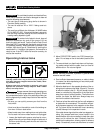
K-6200 Drain Cleaning Machine
Do not put the machine in reverse.
The machine should be kept running during the retrieval
process for thorough cleaning.
NOTE! A continuous flush of water should be used to
clean the cable and tool as they are retrieved.
10. When the tool is just inside the sewer inlet, release the
air foot switch pedal and allow the machine to come to
a complete stop.
Never retract tool from sewer inlet while
cable is rotating. Tool can whip causing serious injury.
11. Turn FOR/OFF/REV Switch to OFF position and re-
move cord from power source.
12. Loosen the feed knob and pull the remaining cable
and tool from the sewer. Hand feed the cable into the
machine.
13. Disengage the spring loaded kickstand bar by tilting the
machine forward, forcing the bar forward of the tires.
(Figure 7)
Special Procedures
Main Sewer Or Septic Tank Overrun
It is very important to know the approximate distance from
inlet to main sewer or septic tank. Over-running cable too
far into main sewer or septic tank can allow cables to
knot-up and prevent their return through small lines.
Reverse Operation
Running machine in reverse will cause premature failure
of cable. Use reverse only to free a tool caught in an ob-
struction. If this should occur, immediately remove foot
from air foot switch pedal and allow machine to come to a
full and complete stop. Place FOR/OFF/REV switch to
REV (reverse) position. Loosen feed knob. Grasp cable
with gloved hands and pull while jogging air foot switch
pedal. When tool is dislodged and drum has stopped ro-
tating, place FOR/OFF/REV switch in FOR (forward)
position and follow normal operating procedure.
Never operate this machine in REV (re-
verse) for any other purpose. Operating in reverse can
damage a cable and cause serious injury.
Ridge Tool Company 9
to allow cutter to work through the obstruction. If
motor turns but the drum stops, the torque limiter is
slipping because of excessive force. Pull back on
cable to relieve torque and drum will begin to spin.
TIP: If cable continues to get hung up in blockage, dis-
continue use of the auto feed and work cable by
hand.
7. Once flow is established, use running water to wash
debris and roots down the drain while finishing the job.
WARNING
Do not allow tension to build up in the cable. This
will happen if the cutting tool hits a snag and stops
turning, but the motor and its drum continue to ro-
tate. Torque builds until the cable suddenly twists,
potentially wrapping around your hand or arm. This
can happen quickly and without warning, so proceed
slowly and carefully as you feed the cable into the
drain. If tool gets hung up in an obstruction, refer to
Reverse Operating Instructions in the “Special
Procedures” section.
Figure 9 – Feed Lever Operation
8. Several passes through thoroughly blocked drain
lines are recommended. Start with a grease cutter or
2″ blade, or a blade typically 2″ smaller than the drain
size. After establishing drain flow, increase cutter
size to thoroughly clean the lines.
TIP: Know approximately where you are going. Over-
running cable into city sewers or septic tanks can
cause cable damage and retrieval problems.
NOTE! Additional cable may be added if required. Refer
to Special Applications Procedure section.
9. To retrieve the cable from the sewer line, move the
power feed handle in the same direction of the drum
rotation.
CAUTION
WARNING
WARNING


















